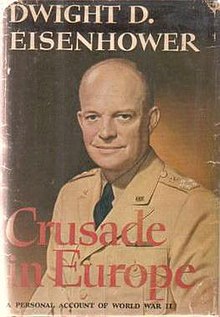This article needs additional citations for verification .(May 2012) |
 First US edition | |
| Author | Dwight D. Eisenhower |
|---|---|
| Subject | European Theater during World War II |
| Genre | Autobiography |
| Publisher | Doubleday (US) Heinemann (UK) |
Publication date | 1948 |
| Pages | xiv, 559 pages |
| ISBN | 9780801856686 |
| OCLC | 394251 |
| LC Class | D743.E35 1948 |
Crusade in Europe is a book of wartime memoirs by General Dwight D. Eisenhower published by Doubleday in 1948. Maps were provided by Rafael Palacios.
Contents
Crusade in Europe is a personal account by one of the senior military figures of World War II. It recounts his appointment by General George Marshall to plan the defense of the Philippines and continues to describe his appointment to, and execution of, the role of Supreme Allied Commander in Northern Europe.
The book was dictated by Eisenhower to Kenneth McCormick of Doubleday and Joseph Fels Barnes, former foreign editor of the New York Herald Tribune . It was revised by Eisenhower's aide Kevin McCann. [1] [2]
Eisenhower's profit on the book was substantially aided by an unprecedented ruling by the Treasury Department that Eisenhower was not a professional writer, but rather, was marketing the lifetime asset of his experiences, and thus only had to pay capital gains tax on his $635,000 advance rather than the much higher personal income tax rate. The ruling saved Eisenhower approximately $400,000. [3]